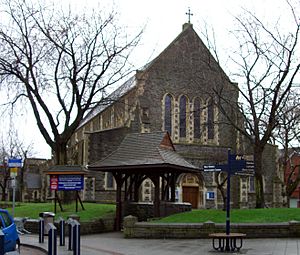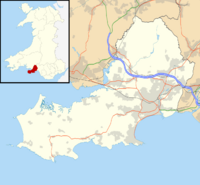St Mary's Church, Swansea facts for kids
Quick facts for kids St Mary and Holy Trinity, Swansea |
|
|---|---|
| The Collegiate & Parish Church of St. Mary's | |
 |
|
| 51°37′08″N 3°56′35″W / 51.619°N 3.943°W | |
| Location | Swansea |
| Country | |
| Denomination | Church in Wales |
| Previous denomination | Catholic Church |
| Website | https://www.swanseastmary.co.uk/ |
| History | |
| Status | Collegiate church |
| Founded | early 13th century |
| Founder(s) | Henry de Gower, Bishop of Saint David's |
| Consecrated | 1959 |
| Architecture | |
| Functional status | Active |
| Heritage designation | Grade II* |
| Designated | 1896,1950 |
| Architect(s) | Arthur Blomfield, Dean Allan Smith |
| Architectural type | Church |
| Administration | |
| Parish | Central Swansea |
| Deanery | Afon Tawe (Swansea) |
| Archdeaconry | Gower |
| Diocese | Swansea and Brecon |
| Province | Wales |
St Mary's Collegiate and Parish Church is an Anglican church in the centre of Swansea, Wales, UK. It is considered the Civic Church of Swansea.
There was a church on the site of St Mary's since circa 1328, erected by Henry de Gower, Bishop of Saint David's. One Sunday morning, in 1739, the roof of the nave collapsed into the church while the congregation was waiting to enter the building. The whole structure was re-built apart from the tower. 1822 saw the church being lit by gas for the first time with thirty six lamps. The church underwent complete renovation between 1879 and 1882 by Vicar Dr Morgan. In 1896, the church was flattened and rebuilt again under the designs of Arthur Blomfield by Dean Allan Smith, though some parts of the old church survived the re-development. In February 1941 the church was extensively damaged by Bombing during the Blitz. It was not rebuilt until the 1950s.
From the 1890s the Swansea Devil stood on a set of buildings facing the west side of the church, constructed by a disgruntled rival of Blomfield's, angry at the commissioning of Blomfield's designs over his own.
Bells
The tower contains eight bells, which were cast in 1959 by John Taylor & Co, Loughborough with the heaviest weighing 20cwt - 2qr - 12lb (1049.2 kg) in "E". Details of the bells:-
| Bell | Weight | Nominal Freq. | Note | Diameter | Year Cast | Foundry |
|---|---|---|---|---|---|---|
| 1 | 5-1-10 (271.9 kg) | 1326.0 Hz | E | 28.25 inches (71.8 cm) | 1959 | John Taylor & Co |
| 2 | 5-2-12 (285.5 kg) | 1249.0 Hz | D# | 29.13 inches (74.0 cm) | 1959 | John Taylor & Co |
| 3 | 5-3-10 (297.3 kg) | 1110.0 Hz | C# | 30.50 inches (77.5 cm) | 1959 | John Taylor & Co |
| 4 | 7-0-18 (364.6 kg) | 986.0 Hz | B | 32.75 inches (83.2 cm) | 1958 | John Taylor & Co |
| 5 | 9-2-9 (487.8 kg) | 876.0 Hz | A | 36.50 inches (92.7 cm) | 1959 | John Taylor & Co |
| 6 | 11-0-1 (560.5 kg) | 825.0 Hz | G# | 38.50 inches (97.8 cm) | 1959 | John Taylor & Co |
| 7 | 15-0-3 (765.1 kg) | 734.0 Hz | F# | 43.13 inches (109.6 cm) | 1959 | John Taylor & Co |
| 8 | 20-2-12 (1049.2 kg) | 654.0 Hz | E | 48.00 inches (121.9 cm) | 1959 | John Taylor & Co |
Images for kids
-
The main door. The most impressive and best preserved part of the door of the blitzed church is the carving above where we see Jesus reigning in heaven surrounded by the four gospel writers in their traditional representations. Matthew is a man, Mark a lion, Luke a bull and John an eagle. This was carved by the notable Mr. Nicholls of Lambeth in London









